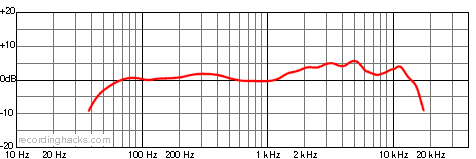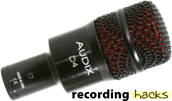 Audix D4
Audix D4
Hypercardioid Dynamic Microphone
The D4 is a hypercardioid dynamic instrument microphone, designed especially for low-frequency reproduction.
Its compact design facilitates positioning around a drum kit, which is the D4’s primary application — kick drum and low toms. Like all dynamic mics, it handles high SPL without breaking up.
Its hypercardioid pickup pattern reduces bleed from nearby sources. It has a transformerless, low-impedance, balanced output circuit.
Like all the D-series mics, the D4 uses Audix’ trademarked VLM Very Low Mass diaphragm, which is said to produce faster transient response and more natural sound.
MIX
I miked a single-headed kick with the D4 mounted on a 5-inch desk stand, and set up directly in front of the kick without a boom. The results were superb, with excellent off-axis rejection.
The D4 case is identical in size and shape to the D1, D2, and D3. All are milled from a solid block of aluminum and finished in black. The grille is made of “spring steel” mesh.
The D4 can be distinguished from the other models by the logo stamped on the mic, and by the color of the fine-mesh blast screen inside the black grille; on the D4, the inner screen is red, as pictured here.
 The headgrille can be removed easily, exposing the dynamic capsule inside. The capsule mechanisms of the D1, D2, and D4 are virtually identical; the capsule diameter is just over 1'', and the inside diameter (approximate coil diameter) is about 22mm.
The headgrille can be removed easily, exposing the dynamic capsule inside. The capsule mechanisms of the D1, D2, and D4 are virtually identical; the capsule diameter is just over 1'', and the inside diameter (approximate coil diameter) is about 22mm.
Recording MagazineI put the D4 up against two of my favorites, an old AKG D12 and an Electro-Voice RE20. While the D12 had a fatter and wider bottom, the D4 had a slightly deeper tone. And the high end on the D4 was much cleaner, minus that D12 midrange honk. Versus the RE20 the D4 had more punch, and again the top end was interestingly different. I certainly found myself using radically different eq than usual, but it still needed a good boost at 60 cycles to put that kick drum right in my chest where I like it.
The mic’s published frequency-response graph has changed since the mic’s introduction, although it is not known whether the change is due to component/design alterations or measurement processes. The earlier chart (circa 2001) showed a rising high-frequency response, peaking at +9dB at 10kHz. The current chart shows a less pronounced boost, +6dB at 5kHz, with a secondary peak above 10kHz. Further, the current chart shows a low-frequency rolloff below 70Hz. (See the older chart in the PDF linked from the sidebar.)
The Audix D4 is also known as: D-4.
The mic was released in 1997.
Specifications
| Frequency Response - HypercardioidClick Graph to Compare! |
|---|
 |
| Pickup Patterns | Pads & Filters |
|---|---|
|
Hypercardioid
(2.1 mV/Pa; 40 - 18,000 Hz) |
|
| Coil Diameter | Impedance | SPL/Noise |
|---|---|---|
| n/a | 200 Ohms (Low) | Max SPL: 144 dB |
| Weight | Length | Max Diameter | Interface(s) |
|---|---|---|---|
| 127g (4.48oz) | 100mm (3.94'') | n/a |
|
| Power Specifications |
|---|
Did we get anything wrong on this page? Please let us know!







